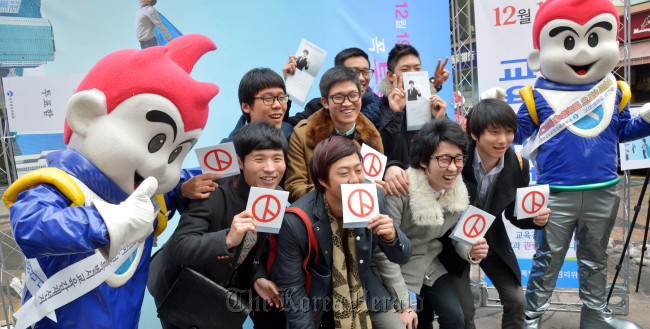
Wednesday’s presidential election is likely to see the biggest-ever clash of generations as the younger and older voters are split almost evenly behind Park Geun-hye and Moon Jae-in, with 40-somethings holding the casting vote.
The election is one of the most tightly contested ever, according to the survey conducted Wednesday by the pollster Realmeter for Herald Corp.
The poll showed the Saenuri Party’s Park’s lead over the Democratic United Party’s Moon had narrowed to 0.1 percent. Although not as dramatic, other opinion polls also showed the gap between the two to have significantly narrowed, with Park’s lead ranging from 0.5 percent to 5 percent. The gap had stood at as wide as 10 percent in polls conducted less than a week earlier.
While the overall approval ratings in most polls show Park in the lead, the two candidates’ support differs sharply by age group.
Moon has overwhelming support from voters under the age of 40, while Park is the candidate of choice for most over the age of 50.

The survey showed that 61.9 percent of voters in their 20s and 63.5 percent of those in their 30s would prefer to see Moon become the next president. In comparison, only 33.9 percent and 31.1 percent, respectively, of the respondents in their 20s and 30s said that they would vote for Park.
The situation with the older voters is the exact opposite. The polls showed that 73.4 percent of those above the age of 60 supported Park, while only 23.3 percent picked Moon.
The skew toward Park was also significant among voters in their 50s, with 61.6 percent favoring Park. Moon’s approval rating from the group came in at 34.5 percent.
In terms of numbers, Park supporters in the four age groups outnumber those of Moon by about 1.5 million.
While youngest and oldest voters stand divided, voters in their 40s, who make up the largest part of the 40.46 million people eligible to vote, appear to be leaning toward Moon.
According to the National Election Commission, those in their 40s accounted for the largest proportion of voters, with just over 8.8 million or 21.8 percent of the total.
With those in the age group having weaker party preferences, and being less concerned with ideologies than practicalities, the 40 to 49 age group is widely considered to hold the casting vote.
The Herald-Realmeter poll showed that Moon has won over more of this age group than the conservative candidate. Of the respondents in this age group, 56.2 percent sided with Moon while 38.3 percent chose Park.
While not as clear cut, results from Gallup Korea for the Dec. 10-12 period also showed that the DUP candidate had a larger appeal to the 40-somethings than Park. Gallup Korea’s results published on Dec. 12 showed that 47 percent of the age group supported Moon, while 45 percent said that they preferred the Saenuri candidate.
As opinion polls predict a tight race, experts say that the so-called hidden voters could play a decisive role in the coming election.
Hidden voters refer to those who are not reflected in polls and those who do not express their true opinions when responding to surveys, which some experts say is a result of the “spiral of silence” theory at work.
The spiral of silence theory posits that people will tend to withhold their views when they perceive themselves to be in the minority.
Experts estimate the number of hidden votes to be between 1.5 million and 2 million ― more than enough to change the outcome in a close race.
In 2002, late former President Roh Moo-hyun clinched victory with 570,000 votes, while the result of the 1997 election was decided with just over 400,000 votes.
As with most issues, the ruling Saenuri Party and the DUP appear to have very different views about hidden votes.
The conservatives are of the position that the phenomenon is caused by the undecided voters and fluctuations in the voting rate. For this year, the Saenuri Party suspects that undecided voters account for 10 percent of the total at most, and that about half of them will not vote.
The DUP, on the other hand, says that hidden votes not only exist but include a significant proportion of those in their early 20s, whom they suspect to hold progressive political views.
By Choi He-suk (cheesuk@heraldcorp.com)
-
Articles by Korea Herald



















